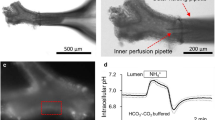Abstract
Protease-activated receptors type 2 (PAR2) are activated by serine proteases like trypsin and mast cell tryptase. The function and physiological significance of PAR2 receptors is poorly understood, but recent studies suggest a role during inflammatory processes in both airways and intestine. PAR2 receptors are also likely to participate in the control of ion transport in these tissues. We demonstrate that stimulation of PAR2 in airways and intestine significantly enhanced ion transport. Trypsin induced CI− secretion in both airways and intestine when added to the basolateral but not to the luminal side of these tissues. In both airways and intestine, stimulation of ion transport was largely dependent on the increase in intracellular Ca2+. Effects of trypsin were largely reduced by basolateral bumetanide and barium and by trypsin inhibitor. Thrombin, an activator of proteinase-activated receptors types 1, 3, and 4 had no effects on equivalent short-circuit current in either airways or intestine. Expression of PAR2 in colon and airways was further confirmed by reverse transcription-polymerase chain reaction. We postulate that these receptors play a significant role in the regulation of electrolyte transport, which might be important during inflammatory diseases of airways and intestine.
Similar content being viewed by others
References
Dery, O., Corvera, C. U., Steinhoff, M., and Bunnett, N. W. (1998) Proteinase-activated receptors: novel mechanisms of signaling by serine proteases. Am. J. Physiol. 274, C1429-C1452.
Lindner, J. R., Kahn, M. L., Coughlin, S. R., Sambrano, G. R., Schauble, E., Bernstein, D., et al. (2000) Delayed onset of inflammation in protease-activated receptor-2-deficient mice. J. Immunol. 165, 6504–6510.
Nystedt, S., Emilsson, K., Wahlestedt, C., and Sundelin, J. (1994) Molecular cloning of a potential proteinase activated receptor. Proc. Natl. Acad. Sci. USA 91, 9208–9212.
Bohm, S. K., Kong, W., Bromme, D., Smeekens, S. P., Anderson, D. C., Connolly, A., et al. (1996) NA, Molecular cloning, expression and potential functions of the human proteinase-activated receptor-2. Biochem. J. 314, 1009–1016.
D'Andrea, M. R., Derian, C. K., Leturcq, D., Baker, S. M., Brunmark, A., Ling, P., et al. (1998) Characterization of protease-activated receptor 2 immunoreactivity in normal human tissues. J. Histochem. Cytochem. 46, 157–164.
Cocks, T. M., Fong, B., Chow, J. M., Anderson, G. P., Frauman, A. G., Goldie, R. G., et al. (1999) A protective role for protease-activated receptors in the airways. Nature 398, 156–160.
Nguyen, T. D., Moody, M. W., Steinhoff, M., Okolo, C., Koh, D. S., and Bunnett, N. W. (1999) Trypsin activates pancreatic duct epithelial cell ion channels through proteinase-activated receptor-2. J. Clin Invest. 103, 261–269.
Kong, W., McConalogue, K., Khitin, L. M., Hollenberg, M. D., Payan, D. G., Bohm, S. K., et al. (1997) Luminal trypsin may regulate enterocytes through proteinase-activated receptor 2. Proc. Natl. Acad. Sci. USA 94, 8884–8889.
Vergnolle, N., Macnaughton, W. K., Al-Ani, B., Saifeddine, M., Wallace, J. L., and Hollenberg, M. D. (2000) Proteinase-activated receptor 2 (PAR2)-activating peptides: identification of a receptor distinct from PAR2 that regulates intestinal transport. Proc. Natl. Acad. Sci. USA 95, 7766–7771.
Chow, J. M., Moffatt, J. D., and Cocks, T. M. Effect of protease-activated receptor (PAR)-1,-2 and-4-activating peptides, thrombin and trypsin in rat isolated airways. Br. J. Pharmacol. 131, 1584–1591.
Buresi, M. C., Schleihauf, E., Vergnolle, N., Buret, A., Wallace, J. L., Hollenberg, M. D., et al. (2001) Protease-activated receptor-1 stimulates Ca(2+)-dependent Cl(−) secretion in human intestinal epithelial cells. Am. J. Physiol. 281, G323-G332.
Levo, Y. and Livni, N. (1978) Mast-cell degranulation in Crohn's disease. Lancet 1, 1262.
Rao, S. N. (1973) Mast cells as a component of the granuloma in Crohn's disease. J. Pathol. 109, 79–82.
Crowe, S. E., Luthra, G. K., and Perdue, M. H. (1997) Mast cell mediated ion transport in intestine from patients with and without inflammatory bowel disease. Gut 41, 785–792.
Author information
Authors and Affiliations
Corresponding author
Rights and permissions
About this article
Cite this article
Kunzelmann, K., Schreiber, R., König, j. et al. Ion transport induced by proteinase-activated receptors (PAR2) in colon and airways. Cell Biochem Biophys 36, 209–214 (2002). https://doi.org/10.1385/CBB:36:2-3:209
Issue Date:
DOI: https://doi.org/10.1385/CBB:36:2-3:209




